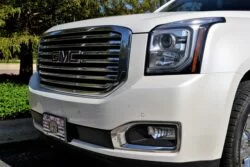The out-of-the-door price is the total amount you would pay after completing a vehicle purchase. It is the sum of all costs of buying a new or used car. Having an understanding of this price gives buyers an opportunity to negotiate better and budget properly.
Keep reading to learn how you can save some money in the process.
READ ALSO: What’s the Difference Between MSRP vs. Invoice Price
What does out-the-door price mean?
The out-of-the-door price is a common term most car buyers hear when shopping for used or new vehicles – cars, motorcycles, trucks, SUVs, and other vehicle types. It is simply the amount you would pay to seal a deal with the dealership and walk out with the keys.
This cost is totally different from the car’s MSRP, also known as the sticker price – we will get a deeper understanding of the difference in other sections. The OTD (out-the-door) price consists of other fees including the extended warranty costs, dealer service fees, dealer handling fees, costs for advertising, taxes, and more.
Just to make sure we’re on the same page, the out-of-the-door price is the amount you would lend from the financing company. Anything less and it just won’t cover all costs.
What does the out-of-the-door price include?
Basically, the out-the-door price covers the following costs:
- Actual sales price of the vehicle
- Sales taxes
- Destination charge
- Registration fees
- Title fees
- Extras
- Warranties, gap insurance, and other financial products
- Documentation fees
- Added dealer markup
- Advertising fees
If you’re making a trade-in or a down payment, these costs are supposed to be deducted from the out-the-door price. So, keep this in mind before and discuss it clearly before signing a contract with the dealership.
How to calculate the out-the-door price
Finding the out-the-door price you pay when car shopping involves considering several factors beyond just the sticker price. Here’s a step-by-step guide:
- Research: Begin by researching the make and model of the car you’re interested in. Look at different dealerships, both online and in person, to get an idea of the average selling price in your area.
- Sticker Price or Market Value: The sticker price, also known as the Manufacturer’s Suggested Retail Price (MSRP), is the starting point. For used cars, the market value of the vehicle can be considered here. However, keep in mind that this is often negotiable.
- Additional Fees: Be aware of additional fees that may be added to the total price. These can include taxes, registration fees, documentation fees, and any optional add-ons like extended warranties or accessories.
- Negotiation: When negotiating with the dealership, focus on the out-the-door price rather than just the sticker price. This includes all fees, taxes, doc fees, and others. Be prepared to negotiate and don’t be afraid to walk away if you’re not getting a fair deal.
- Financing: If you’re financing the car, consider the interest rate and auto loan term. These factors will affect the total amount you pay over time. Get pre-approved for a car loan from a bank or credit union before visiting the dealership to have a benchmark for comparison.
- Trade-In: If you have a trade-in, consider its value in the negotiation. You can use online calculators or get quotes from multiple dealerships to determine its worth.
- Finalizing the Deal: Once you’ve negotiated a price, carefully review the sales contract to ensure that the out-the-door price matches what you agreed upon. Make sure there are no unexpected fees or charges added.
- Payment: When making the car payment, be prepared to pay the out-the-door price in full, whether by cash, check, or financing.
By following these steps, you can ensure that you get an accurate out-the-door price when car shopping, helping you make an informed decision and avoid any surprises during the buying process.
READ ALSO: 3 Questions to ask before buying a Used Car
Negotiate Based on the out-the-door price
You need to try to place more focus on the out-the-door price when negotiating. If you are unable to calculate it yourself using the methods listed above, you can ask the dealer about the price or use online OTD price calculators.
You really need to negotiate the out-the-door price and here are some reasons why:
- Knowing the OTD price helps you to focus on one number and improves clarity.
- It reveals all hidden costs and charges. By focusing on the out-the-door price, you can easily compare offers from different dealerships.
- It helps you budget more effectively as it gives a more realistic estimate of how much you’ll need to pay upfront.
- It allows you to negotiate from a position of strength, as you’re clear about what you’re willing to pay and won’t be swayed by misleading offers or incentives.
Some car buyers make the mistake of paying more attention to the monthly payments than the full price for their cars and this is just what dealers want. By negotiating based on monthly payments alone, you might overlook additional fees, taxes, and other charges that are rolled into the financing agreement. This can result in a higher overall price for the vehicle.
Dealers can also suggest longer loan terms to lower the monthly payments, which can seem more affordable in the short term. However, longer loan terms typically result in paying more interest over time, increasing the total cost of the vehicle.
By negotiating with the OTD in mind, you get to save a lot of money and you can significantly avoid overlooking the true price of the car.
Focus on the out-the-door price when shopping online
If you prefer online shopping and marketplaces than visiting the dealership, you can still apply the same tactics of negotiation here. Make sure that you know the average market value of the vehicle you are interested in and calculate the out-of-the-door price.
One tip for a better purchase is to check several listings to get the best deals. If you are buying a used car, just to be safe, it’s recommended you get a detailed vehicle history report. This way, you can be sure that you are not being tricked into buying a lemon or damaged vehicle with title brands.
A VIN check tool does the trick here. With a detailed vehicle history report, you can easily get the following information on any used car within seconds:
- Accident history
- Auction records with more than 10 photos
- Sales History
- Damage Records
- Vehicle specifications
- Lien and loan records
- Open recalls
- Market Value
- Theft records
- Ownership History
- Title-brand records
- Warranty information
- OEM maintenance schedules
- Service history, and more.
Getting a VIN check before committing to any used car purchase ensures you don’t fall victim to online car scams.
Out-the-door price vs. MSRP: What is MSRP?
The manufacturer’s suggested retail price, mostly known as the MSRP, of a vehicle is the suggested cost of the vehicle. It is the recommended sales price of purchasing a new vehicle from a dealership.
Knowing the MSRP can help car buyers have an idea of the final cost of purchasing the new car they are interested in. It doesn’t include taxes, dealer costs, and other costs, but it’s a good starting point.
You should know the difference between the MSRP and out-the-door price by now:
- The car’s out-the-door price is always higher than the MSRP of a vehicle as it covers the MSRP and additional expenses.
- The MSRP is just a suggested price and can be found on the window sticker, usually attached to new vehicles.
- The out-the-door price provides a clear and comprehensive view of the total cost of purchasing the vehicle, leaving no room for surprises or hidden costs.
Buying a new car? Need to check the MSRP of a vehicle? You can use our window sticker by VIN lookup tool anytime.
Overall, having an idea of the out-the-door cost empowers buyers to negotiate effectively and budget wisely, ensuring a transparent transaction. Save some money today by negotiating the right way with the out of the door price.
Frequently Asked Questions
The out-the-door price is calculated by adding the actual sales price of the vehicle to all associated costs, including sales taxes, destination charges, registration fees, title fees, extras, warranties, documentation fees, dealer markup, and advertising fees. Remember that any trade-in value or down payment should be deducted from this total.
A car’s final price, also known as the out-the-door price, is the total amount a buyer pays after completing the purchase. What’s included in the out-the-door price? It includes all costs associated with buying the car, such as the actual sales price, taxes, fees, and any optional add-ons.
The Manufacturer’s Suggested Retail Price (MSRP) is the price recommended by the manufacturer for selling a new vehicle. The dealer price, on the other hand, is the actual price negotiated between the buyer and the dealer, which may be lower than the MSRP due to discounts, incentives, or negotiation tactics.










